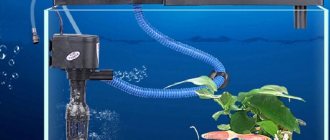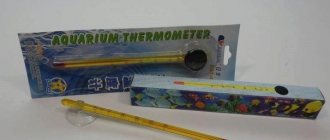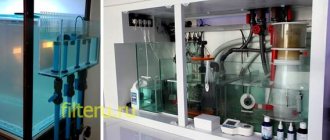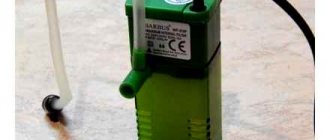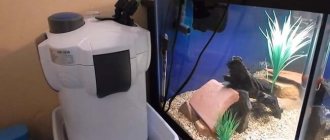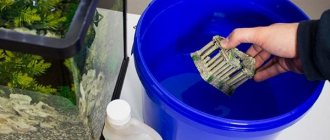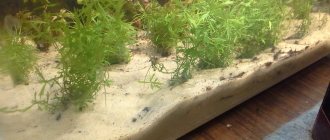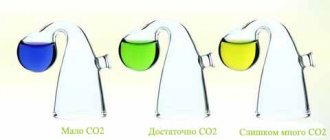Home/EQUIPMENT/Aquarium pump: types and everything you need to know about it
There are much more living organisms and plants in an aquarium than in the same volume of water in a natural reservoir. This is one of the reasons for rapid water pollution. A larger volume of water makes it easier to cope with disturbances in biological balance. An aquarium pump helps partially solve this problem for small home ponds. Without it, most aquarium fish will float on their backs, because this device performs the functions of purifying the aquatic environment.
What is the pump for?
Its main task is to ensure the normal functioning of the aquarium: pumping and mixing water, supplying oxygen. It is this that creates the pressure necessary for the operation of the external filter. If necessary, it helps to create a current in the water, promotes the operation of the aerator, and slows down the process of contamination of the tank.
There are several varieties of this device:
- internal type;
- external (or external);
- universal model.
SunSun
Another Chinese company specializing in the production of various devices also produces submersible pumps. They are characterized by high energy saving. Compared to devices of other brands, SunSun devices save electricity up to 65%.
- On sale you can find SunSun submersible pumps with five types of power.
The operation of the pump is ensured by a silent electric motor located in the head of the device. All parts connected to the power source are securely isolated in a sealed housing . The shaft is made of ceramic , which guarantees a long service life. At the front of the pump there is a multi-layer filter. It protects the rotor and impellers from dirt. The cleaning ability of the impeller is pumping solid particles up to 6 mm in size.
Models with the following characteristics are available for sale:
| Performance | Power |
| Up to 100 l/h | 6 W |
| 400 l/h | 12 W |
| 800 l/h | 20 W |
| 1200 l/h | 25 W |
| 2500 l/h | 45 W |
What are there
In real reservoirs, oxygen is supplied by wind flow and water vibrations. In a closed container, aquarium pumps are responsible for this process.
The pumps differ:
- By design. There are piston and diaphragm options.
- By installation. There are submersible and external.
Piston devices will last a long time, and they are more powerful than membrane ones. Their disadvantage is that they make a lot of noise and vibrate. Such devices should be used for aquariums with a volume larger than 200 liters. Diaphragm pumps operate silently and consume minimal energy. They have one drawback - they are suitable for containers up to 150 liters.
Equipment that is submerged under water is secured using clamps or suction cups. The external model is installed behind the aquarium. It is designed for small containers and is also suitable for growing demanding fish. You can easily secure the aquarium pump with your own hands.
Kinds
The choice depends on the size of the container. For small ones, a low-power one is suitable, for large ones - with higher performance.
Based on the installation method, the following types of devices are distinguished:
- internal;
- external;
- universal.
The external filter is installed outside the rear wall, the internal filter is installed inside. The universal device can be mounted as desired: inside or outside. The filter is attached using suction cups and clamps that are included in the kit.
Freshwater and saltwater aquariums also require different pumps. In freshwater tanks, a device with a metal axis is installed, and in sea tanks - with a ceramic one, since in salt water the metal quickly oxidizes and rusts.
Basic selection rules
When choosing a pump, you should take into account the power of the device and the volume of the aquarium - you can see a good selection of pumps for an aquarium here. To service a small one, a low-power model is enough. Especially if it will only be used to supply water. For containers with a volume of more than 250 liters, you will need a more powerful option.
It is also necessary to take into account the height of the water rise (this indicator depends on the volume of the tank). The larger the capacity, the more powerful the pump is needed. The one that pumps from 3 to 5 volumes per hour is considered effective.
Another important point when purchasing a pump is the type of aquarium (sea or freshwater). For each variety you need to select the appropriate model
Loading…
Pump manufacturers
Using a pump, you can maintain the necessary microflora in the aquarium. When choosing equipment, you should give preference to leading manufacturers specializing in aquarium equipment:
The manufacturer Eneim provides the buyer with a 3-year warranty.
Modern devices are able to eliminate contaminants, move layers of water, maintain temperature balance, the amount of necessary oxygen and a constant influx of microorganisms and beneficial bacteria.
How to properly install a pump in an aquarium
Instructions The simplest pump consists of a glass containing a filter sponge, a motor and water pipes. Let's figure out how to install the device in an aquarium: The purchased pump should be assembled according to the instructions. Many modern models have two types of fastening: vertical and horizontal (suction cups); when installing on suction cups, the vertical fastening should be removed. Next, choose a suitable place on the wall of the aquarium, preferably in a corner, press the suction cups against the glass. If mounting on a vertical bracket, secure it to the edge of the tank. To improve cleaning and aeration, it is better to direct the water flow along the wall of the aquarium. If there is a need for two devices, their flows must be directed in different directions. You need to install the pump when all decorative items and soil are already placed in the container. Important! The submersible version of the device should not be located above water and should not operate dry. Also, you should not check the operation of the internal filter in an empty aquarium.
Aquarium systems
The French manufacturing company offers a wide selection of submersible pumps for aquariums. The devices are multifunctional, they are completely sealed and reliably insulated. All models are designed for both freshwater and seawater aquariums.
The exclusive design of the pump ensures that the power supply is blocked in case of engine overheating or power outages. Also, the device turns off automatically in case of excessive vibration and unusual noise.
Aquarium systems products are reliable and durable. As a rule, it lasts longer than the expiration date stated by the manufacturer.
3. Submersible pump “Aquarium systems”.
Models of the “MAXI JET” type are used for aquariums
They meet the following characteristics:
- They have an adjustable outlet with durable fasteners for all types of rigid soft and hard hoses.
- Equipped with three powerful suction cups that securely fix the device in the aquarium. for, as well as for more stable mounting and operation, the pump has three supporting suction cups.
Important! The device cannot be used at water temperatures above +350 C. Also, it is necessary to take into account the limiting immersion depth. It is individual for each model. pump is 1 m, counting from the beginning of the water level in the aquarium system.
Operation and care
During operation, external filters do not cause any trouble to their owners. The aquarist should only remember that turning off equipment at night is strictly prohibited. If for any reason the electricity in the house is turned off for 12 hours or more, then the nitrifying bacteria on the substrate die, and the aquarium will need to be started again. Such equipment must operate around the clock, which will ensure high-quality purification of aquarium water. Caring for the external filter is not difficult. Once a month, you should open the case and wash the sponges to remove any existing dirt. This work is done as quickly as possible and takes 5-10 minutes.
After washing the sponges, you will also need to bleed the system from air, for which you use a hand pump that expels unnecessary air from the tubes. The system is thoroughly flushed approximately once a year. To do this, you should drain 10-15 liters of water from the aquarium into a small basin. The filter is disconnected from the power supply, disassembled, all fillers are washed in a basin of water, after which the cleaning equipment is assembled in the reverse order. This work is usually not difficult and takes 20-30 minutes at most.
Installing an internal or external aquarium filter is quite simple. You just need to decide on the location, be careful during assembly, and connect the device to the network only after the equipment is fully installed. In the future, it will be necessary to properly maintain the equipment , washing it regularly, and avoiding long-term power outages, which subsequently leads to the need to restart the filter and the entire aquarium.
Popular models
Models from different manufacturers have their own advantages and disadvantages; each model also differs from the other in appearance, equipment, availability of adjustments, price and quality. In aquarium circles, pumps from the following manufacturers have good reviews:
- Eheim - devices belong to a universal group according to the installation method. Perfect for different types of aquariums. The power of these pumps can also be adjusted.
- Resun - affordable models for small and medium capacity tanks. The lowest productivity is 200 l/h.
- Hailea - devices of this brand are equipped with suction cups and a power regulator, and are available for containers of different sizes.
- Aquael – the smallest capacity of these devices is 350 l/h, suitable for small and medium-sized containers.
- Aquarium system - high-quality devices equipped with overheating protection and flow power regulator.
- Tunze are proven and reliable pumps with different power ratings. They are good because they do not make noise during operation.
If store-bought pumps do not suit the aquarist, then if you have experience and knowledge, you can try to make a water pump yourself. If this is your first experience assembling equipment at home, then it is better to take risks - an incorrectly assembled structure can lead to dire consequences.
Homemade aquarium pump: pros and cons
The main advantages of a homemade device: saving money; if you know how to work with your hands, assembling a pump from available materials will not take much time; the device can be modified according to your wishes and needs of the inhabitants of the aquarium; If desired, the device can be given an aesthetic appearance that matches the decor of the container. The downside can be considered possible errors in work, for example, insufficiently strong sealant or inaccuracy in calculations.
Features of choosing and using pumps for a marine aquarium
Saltwater aquariums usually contain corals and various sponge species as natural water purifiers. Both of them, as well as fish in their natural habitat, are dependent on the current. All life cycles, the availability of food, and the change of seasons for marine inhabitants are associated with the current. Taking this important factor into account, current pumps are installed on tanks containing seawater inhabitants, which also perform the function of cleaning and aeration. The following nuances need to be taken into account: For ten to twelve hours, the pump must be turned off, simulating calm. The volume of pumped water per hour should be approximately fifteen times the volume of the tank. The water flow is directed to the bottom stones. For large containers, it is recommended to purchase two devices.
Assembling a device for your silent pets yourself is not difficult and does not take long, especially for those who know at least a little about the operation of such devices. If you don’t have the skills, you can look for a budget option, but in any case, this device is vital for aquatic life.
Device functions
Regardless of which pump manufacturer, size and power the client chooses, it must perform certain functions:
- Create a flow of water masses inside the aquarium, since without this the fish cannot exist. In an aquarium where there are corals, there is no way to do without such a pump, since only through the flow do the corals receive the necessary nutrients.
- Circulate the water. Thanks to circulation, the water is purified and filled with oxygen. The pump also mixes purified water with the remaining water, which retains the microclimate created by fish and corals.
- Help the operation of filters and other devices installed in the aquarium. Therefore, it is important to install the pump so that water from the aquarium does not fall on its body.
If the selected pump in the aquarium meets these parameters and does not cause any malfunctions, then it is suitable for a certain aquarium.
Compressor or filter?
wlaadd Participant 46 1 Kursk region. Rylsk
Compressor or filter?
Post by wlaadd » Mar 19, 2012 11:44 am
Friends, help me with this question. I have a 60 liter jar. in which the brocade catfish lives and about 5 other small things - neons and zebrafish. Until this time, there was a Fan 1 aerator. If you just install a compressor instead, will more growths and mucus appear on the walls (after all, water filtration will be reduced)? My catfish loves them very much. Thank you in advance for your response.
Natalya Elderishina 4519 2804 St. Petersburg, Kolpino
Compressor or filter?
Post by Natalya » March 19, 2012, 11:53 am
If you remove the ptera (it is not for this volume in principle), then the rest can do without anything at all (if they are in the specified quantity and there are not a few living plants).
In general, a filter is always better. Just try to let the current flow along the surface (so that there is a slight disturbance of the water), it should be enough, look at the behavior of the fish. If they don’t hover near the surface, then everything is fine and a compressor is not needed.
What is the reason for this need in general? Fan1 is generally a filter and it is not obliged to let bubbles out))) I mean, you can simply remove the nozzle, and in terms of noise it is quieter than any compressor.
mister_xxi Own on the forum 239 364 St. Petersburg, Ladozhskaya metro station
Compressor or filter?
Post by mister_xxi » Mar 19, 2012, 11:59 am
wlaadd wrote:Fan 1
This is a filter that should be in the aqua in any case, and the aerator is at your discretion. If there are enough plants in the jar, then aeration may not be necessary. Brocade has no place at all in 60 liters! IMHO
Natalya is ahead
Of course, it is no longer possible to correct me... but to completely ruin me is still possible...!!!
..When you have a twenty-liter bottle, you want a fifty-liter one... Then a hundred, then... And where to live... (I. Marquez)
Uncle Vova Elder 6747 4434 St. Petersburg st. Volunteers
Compressor or filter?
Message by Uncle Vova » March 19, 2012, 12:10
wlaadd wrote: Until this time there was a Fan 1 aerator.
Internal filters of this type are designed for both functions - both the filter itself and the aerator (partially performing the role of a compressor). But this unit is adjustable. It can be configured to function as a pure filter (if you remove the air intake tube), but you can increase the air supply (aeration) by reducing the filtration volume. To do this, you need to completely free the hose tip from the cap.
So, by increasing filtration, we reduce aeration and vice versa.
But many aquarists, in addition to the inner tube, also install a compressor if they need to significantly increase the air supply.
So it all depends on the specific situation - volume, population, number of plants.
Doubt is the path to truth.
wlaadd Participant 46 1 Kursk region. Rylsk
Compressor or filter?
Post by wlaadd » Mar 19, 2012, 02:07 pm
I understand everything perfectly well, and that brocade has no place there, and that the water needs to be filtered... The question is, what will happen if you turn off the filter and leave aeration with the compressor? What changes will happen?
wlaadd Participant 46 1 Kursk region. Rylsk
Compressor or filter?
Post by wlaadd » Mar 19, 2012, 8:03 pm
It seems that the dear regulars of the forum will not give an answer to a question that goes somewhat beyond the truisms. It's a pity. You'll have to experiment yourself.
Yu.V. Elder 24741 11302 Kyiv
Compressor or filter?
Message from Yu.V. » March 19, 2012, 20:29
In my opinion, you have been given an exhaustive answer. In short, there must be a filter, especially in your case, when there is a large fish in a small volume that raises turbidity. Fouling on glass does not depend on the presence or absence of a filter.
Natalya Elderishina 4519 2804 St. Petersburg, Kolpino
Compressor or filter?
Post by Natalia » March 19, 2012, 10:01 pm
wlaadd wrote: It seems that dear regulars of the forum will not give an answer to a question that goes somewhat beyond the truisms.
No, they answered you right away, you just didn’t want to see the answer
A student wrote: the rest can do without anything at all
Uncle Vova wrote: So it all depends on the specific situation - volume, population, number of plants.
It is impossible to answer the question without knowing anything, because we are not clairvoyant))) And after you called the filter an aerator (this indicates that you do not have much experience in aquarium farming), we considered it necessary to clarify what the goals of the question are and, if possible, decipher our answers )))
A student wrote: What is the reason for this need in general?
But, if you want a specific answer, then please.
wlaadd wrote: What changes will happen?
A lot of suspended matter will appear in the aquarium, with all the ensuing consequences.
wlaadd Participant 46 1 Kursk region. Rylsk
Compressor or filter?
Post by wlaadd » Mar 20, 2012, 03:02
The student wrote: A lot of suspended matter will appear in the aquarium, with all the ensuing consequences.
No, I don't need the suspension. I hoped that without filtering the water, algae and mucous deposits on the walls would begin to develop more actively; I repeat, catfish love them. Well, the experiment is cancelled. Thanks for the advice.
Everything will be fine - we will all die
Uncle Vova Elder 6747 4434 St. Petersburg st. Volunteers
Compressor or filter?
Post by Uncle Vova » March 20, 2012, 03:21
wlaadd wrote: algae and mucous deposits on the walls develop more actively
Let’s move further discussion of fouling to “Algae and Plants.”
Doubt is the path to truth.
Return to “Aquarium Equipment”
Light level adjustment
An optimal microclimate can only be created if lighting is properly organized. For this purpose, lamps with different spectrum and power are used. Taking into account these characteristics, when equipping a marine aquarium, it is recommended to use the following types of lamps:
Metal halide
Power ranges from 250 to 500 W. Thanks to this, light is perfectly scattered in the water column. One lamp is enough to provide the required level of illumination for a pond 80 cm high.
Bandwidth
A homemade or factory-made pump for an aquarium must have the necessary throughput. Using this parameter, the water flow necessary to meet the physiological needs of living organisms is created. In simple words, the calculated pumping value of 100 liters of capacity is ensured by a pumping capacity of 300-500 l/h.
According to the established rules, the pump capacity must correspond to pumping five volumes of the reservoir used. According to calculations, the pump should pump 3-5 such aquariums per hour of operation. Proper circulation not only cleans the aquatic environment, but also transfers oxygen there, maintaining a comfortable microclimate for fish and other inhabitants.
How the device works
The operating principle of an aquarium compressor is extremely simple. Tubes and special sprayers, which can be made of porous stone, various types of wood and other similar materials, are immersed in water. Under pressure, an aquarium air compressor supplies oxygen to the tubes, after which tiny bubbles emerge from the sprayers, which dissolve in the water and create movement of the surface layer.
The aquarium compressors used can vary significantly in their power and productivity, which is expressed in liters per hour. It is necessary to correctly select the power of such air pumps, which will not only allow you to properly aerate the water, but will also prevent the effect of a washing machine, when, due to the high power of the pump, the water in the aquarium is constantly in motion, creating not very comfortable living conditions for aquatic organisms.
The use of such devices makes it possible not only to saturate the water with oxygen, but also to mix the water, preventing its spoilage and blooming. Today, the design of aquarium compressors has been simplified to the limit, which ensures their durability, reliability and ease of operation. By correctly positioning the transparent tubes and sprayer in the aquarium, it will be possible to create many air bubbles, which further adds decorative value to the underwater garden.
In the recent past, it was believed that it was necessary to constantly turn on the compressor to supply air to the aquarium. However, with the advent of special devices for measuring the oxygen concentration in water, most experienced aquarists recommend turning on compressors to supply oxygen only in the dark, when plants actively consume oxygen from the water, which can lead to the death of fish.
The intensity of oxygen supply should be increased in the hot season, when the activity of living creatures increases, and accordingly they require more oxygen. But in winter, especially in aquariums that are well lit and have a large number of living plants, it is better to reduce the intensity of aeration.
